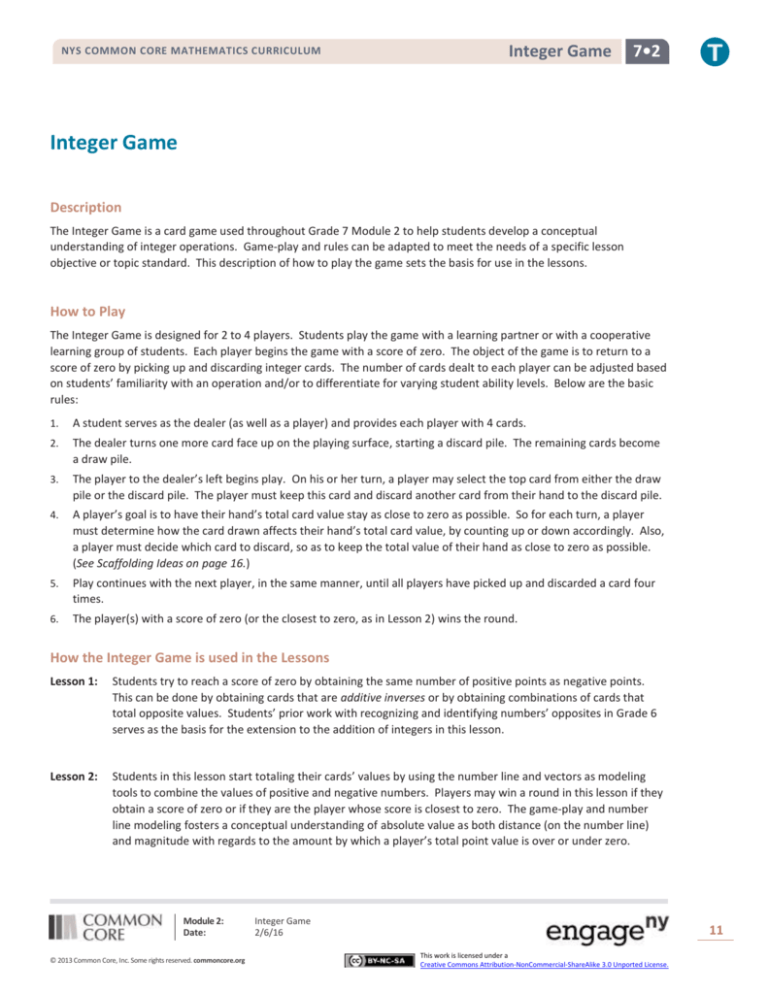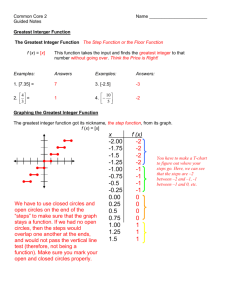
NYS COMMON CORE MATHEMATICS CURRICULUM
Integer Game
7•2
Integer Game
Description
The Integer Game is a card game used throughout Grade 7 Module 2 to help students develop a conceptual
understanding of integer operations. Game-play and rules can be adapted to meet the needs of a specific lesson
objective or topic standard. This description of how to play the game sets the basis for use in the lessons.
How to Play
The Integer Game is designed for 2 to 4 players. Students play the game with a learning partner or with a cooperative
learning group of students. Each player begins the game with a score of zero. The object of the game is to return to a
score of zero by picking up and discarding integer cards. The number of cards dealt to each player can be adjusted based
on students’ familiarity with an operation and/or to differentiate for varying student ability levels. Below are the basic
rules:
1.
A student serves as the dealer (as well as a player) and provides each player with 4 cards.
2.
The dealer turns one more card face up on the playing surface, starting a discard pile. The remaining cards become
a draw pile.
3.
The player to the dealer’s left begins play. On his or her turn, a player may select the top card from either the draw
pile or the discard pile. The player must keep this card and discard another card from their hand to the discard pile.
4.
A player’s goal is to have their hand’s total card value stay as close to zero as possible. So for each turn, a player
must determine how the card drawn affects their hand’s total card value, by counting up or down accordingly. Also,
a player must decide which card to discard, so as to keep the total value of their hand as close to zero as possible.
(See Scaffolding Ideas on page 16.)
5.
Play continues with the next player, in the same manner, until all players have picked up and discarded a card four
times.
6.
The player(s) with a score of zero (or the closest to zero, as in Lesson 2) wins the round.
How the Integer Game is used in the Lessons
Lesson 1:
Students try to reach a score of zero by obtaining the same number of positive points as negative points.
This can be done by obtaining cards that are additive inverses or by obtaining combinations of cards that
total opposite values. Students’ prior work with recognizing and identifying numbers’ opposites in Grade 6
serves as the basis for the extension to the addition of integers in this lesson.
Lesson 2:
Students in this lesson start totaling their cards’ values by using the number line and vectors as modeling
tools to combine the values of positive and negative numbers. Players may win a round in this lesson if they
obtain a score of zero or if they are the player whose score is closest to zero. The game-play and number
line modeling fosters a conceptual understanding of absolute value as both distance (on the number line)
and magnitude with regards to the amount by which a player’s total point value is over or under zero.
Module 2:
Date:
© 2013 Common Core, Inc. Some rights reserved. commoncore.org
Integer Game
2/6/16
11
This work is licensed under a
Creative Commons Attribution-NonCommercial-ShareAlike 3.0 Unported License.
NYS COMMON CORE MATHEMATICS CURRICULUM
Integer Game
7•2
Lesson 3:
The Integer Game is used as a point of reference in Lesson 3 as the addition of integers becomes formalized.
Lesson 4:
The Integer Game is again used as a point of reference in Lesson 4. Its simulation is used by students to
justify the rules for adding integers.
Lesson 5:
Students examine how picking up (adding) integer cards and laying down (subtracting) integer cards affects
their score. They know that from earlier game-play that adding a positive value increases their score while
adding a negative value decreases their score. Students also recognize that laying a card down is the
opposite of picking a card up, so laying a card down represents subtraction. They understand that when a
positive value is taken out of their hand their score decreases, but when a negative value is taken out of
their hand their score increases. This serves as the basis for students’ conceptual understanding of
subtraction as “adding the opposite.”
Lesson 10: Students consider scenarios involving multiple sets of cards. They understand that picking up multiple cards
of the same value is repeated addition of that value, and when the value is negative, it is the same as
repeated subtraction of that value. They realize that laying down multiple negative cards (the opposite
move) represents multiplying a negative integer by a negative integer. Examining these scenarios supports
the development of the rules for multiplying integers (and eventually all signed numbers) in Lesson 11.
Lesson 11: The Integer Game is used as a point of reference in Lesson 11 as students use various scenarios as described
in Lesson 10 to justify of the rules for multiplying signed numbers.
Lesson 12: The Integer Game is revisited to model properties of equality (using “if-then” statements). Students will use
sets of cards with the same total score but different card values to explore what happens to the scores when
equal values are added, subtracted, multiplied, or even divided from each of the hands.
Module 2:
Date:
© 2013 Common Core, Inc. Some rights reserved. commoncore.org
Integer Game
2/6/16
12
This work is licensed under a
Creative Commons Attribution-NonCommercial-ShareAlike 3.0 Unported License.
Integer Game
NYS COMMON CORE MATHEMATICS CURRICULUM
7•2
The Integer Cards
1
2
3
4
5
6
7
8
9 10 11 12
Module 2:
Date:
© 2013 Common Core, Inc. Some rights reserved. commoncore.org
Integer Game
2/6/16
13
This work is licensed under a
Creative Commons Attribution-NonCommercial-ShareAlike 3.0 Unported License.
NYS COMMON CORE MATHEMATICS CURRICULUM
Integer Game
7•2
–1 –2 –3 –4
–5 –6 –7 –8
–9 –10 –11 –12
Module 2:
Date:
© 2013 Common Core, Inc. Some rights reserved. commoncore.org
Integer Game
2/6/16
14
This work is licensed under a
Creative Commons Attribution-NonCommercial-ShareAlike 3.0 Unported License.
Integer Game
NYS COMMON CORE MATHEMATICS CURRICULUM
0
Module 2:
Date:
© 2013 Common Core, Inc. Some rights reserved. commoncore.org
7•2
0
Integer Game
2/6/16
15
This work is licensed under a
Creative Commons Attribution-NonCommercial-ShareAlike 3.0 Unported License.
Integer Game
NYS COMMON CORE MATHEMATICS CURRICULUM
7•2
Scaffolding Ideas for Diverse Learners
Include a number line representation on the cards.
Include counters on the cards
-5
Module 2:
Date:
© 2013 Common Core, Inc. Some rights reserved. commoncore.org
3
Integer Game
2/6/16
16
This work is licensed under a
Creative Commons Attribution-NonCommercial-ShareAlike 3.0 Unported License.









